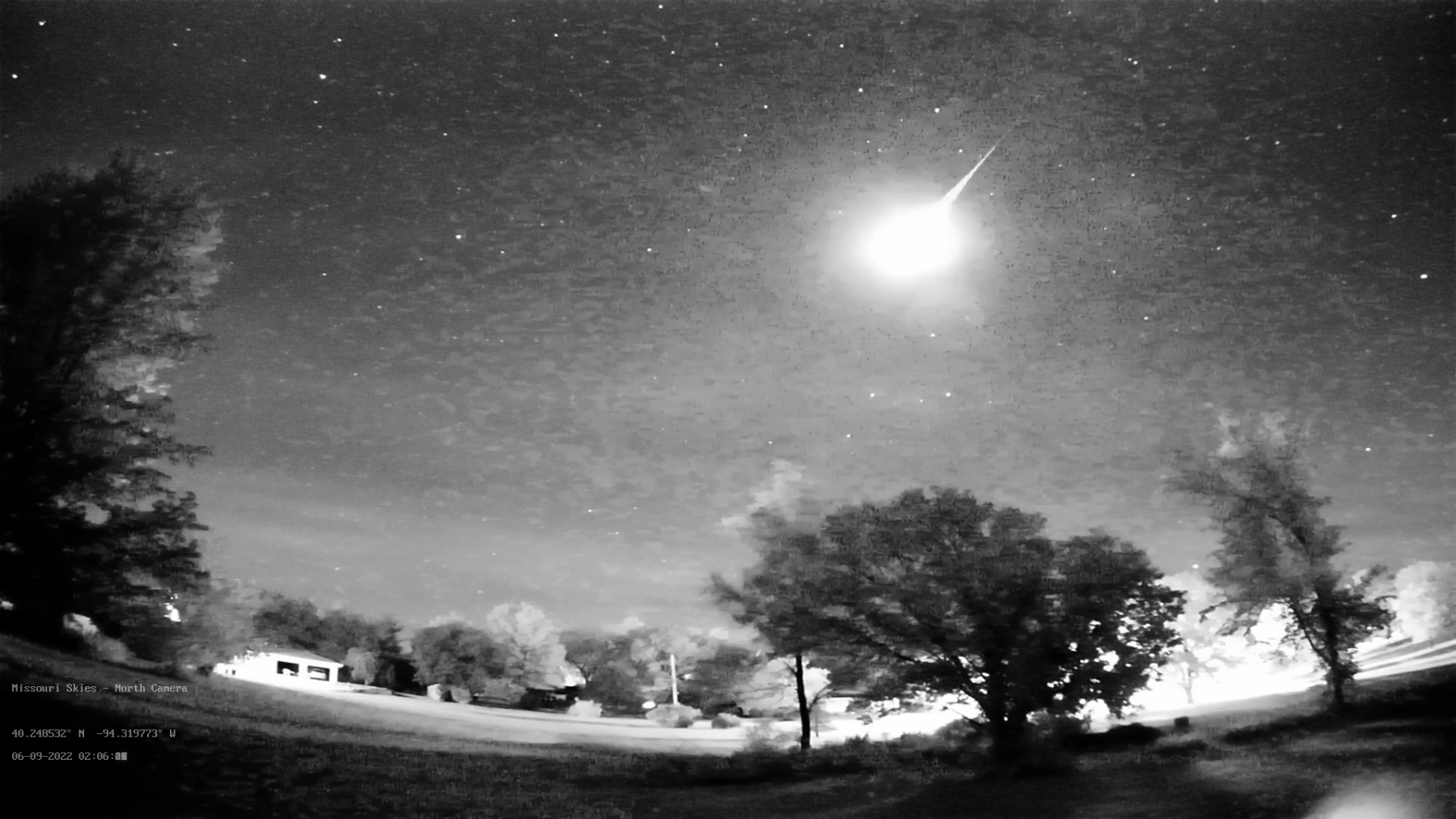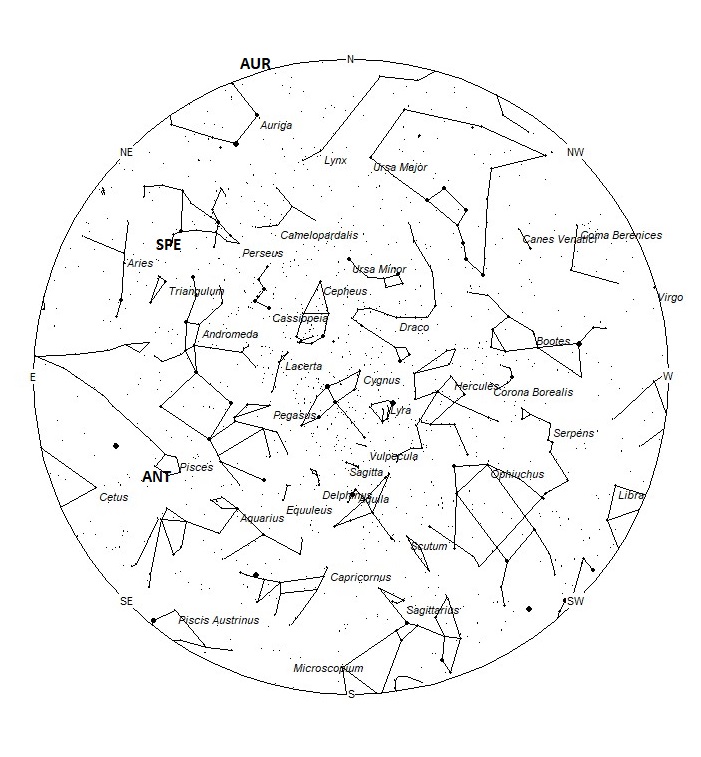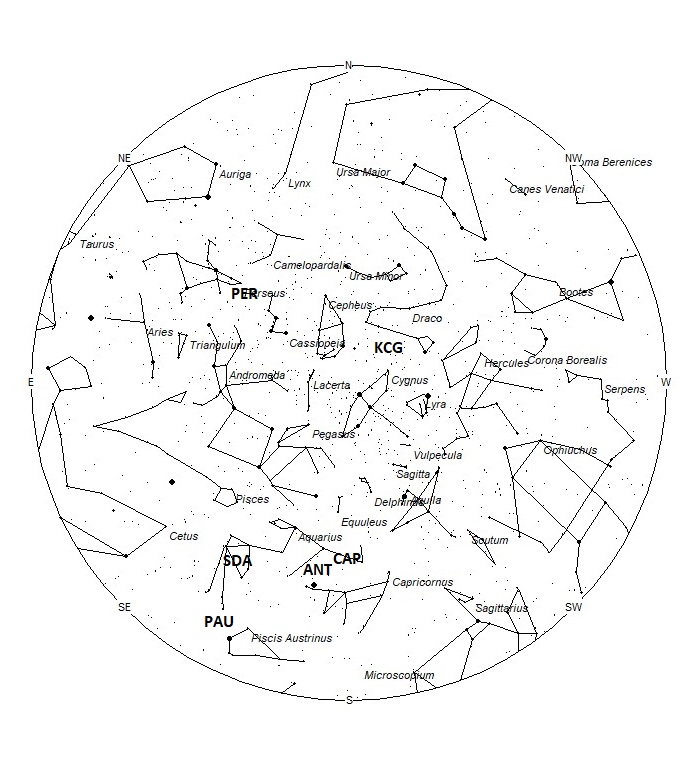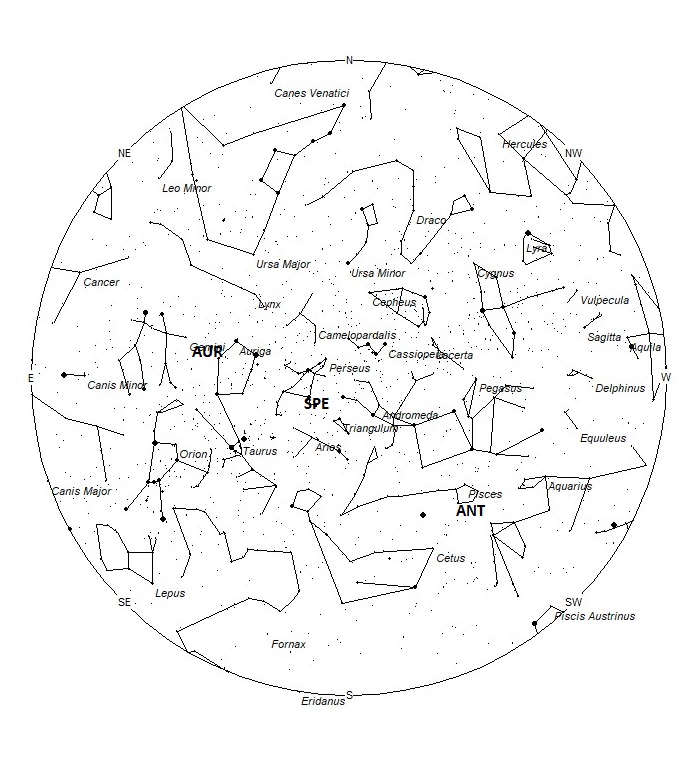 Daniel Bush captured this fireball low in the eastern sky at 07:06 UT on June 3rd 2022 (02:06 CDT), from Albany, Missouri USA. For more information on this fireball visit: https://fireball.imo.net/members/imo_view/event/2022/3360 ©Daniel Bush
Daniel Bush captured this fireball low in the eastern sky at 07:06 UT on June 3rd 2022 (02:06 CDT), from Albany, Missouri USA. For more information on this fireball visit: https://fireball.imo.net/members/imo_view/event/2022/3360 ©Daniel BushSeptember offers longer nights in the Northern Hemisphere that tend to be less hazy than those experienced in mid-summer. In the sky, no major showers are visible from either hemisphere, but the Northern Hemisphere enjoys the advantage of higher sporadic rates. Most of the shower activity this month is produced from the Perseus-Aurigid complex active this time of year. These showers rarely produce more than 5 meteors per hour but still manage to produce most of the shower activity seen this month. Unfortunately, the Perseus-Aurigid complex lies too low in the northern sky for southern hemisphere observers to view very well. Video studies have shown that the Taurids are visible as early as September 20th, therefore after this date the Anthelion radiant will no longer be listed until the Taurid showers end in December. The Anthelion meteors are still active but their radiant is superimposed upon that of the more numerous Taurids, therefore it is impossible to properly separate these meteors. Observers in the Southern Hemisphere suffer from some of their lowest rates of the year this month. The Taurid radiants are not too badly placed so observers south of the equator can expect to see a little of this activity from this source this month.
During this period, the moon reaches its first quarter phase on Saturday September 3rd. At that time the moon will lie 90 degrees east of the sun and will set near 23:00 Local Summer Time (LST). As the week progresses the waxing gibbous moon will begin to interfere upon the more active morning hours. Toward the end of the period, the nearly full moon will lie above the horizon most of the night. The estimated total hourly rates for evening observers this week should be near 3 as seen from mid-northern latitudes (45N) and 2 as seen from tropical southern locations (25S) For morning observers, the estimated total hourly rates should be near 15 as seen from mid-northern latitudes (45N) and 10 as seen from tropical southern locations (25S). Evening rates are reduced due to interfering moonlight. The actual rates will also depend on factors such as personal light and motion perception, local weather conditions, alertness, and experience in watching meteor activity. Note that the hourly rates listed below are estimates as viewed from dark sky sites away from urban light sources. Observers viewing from urban areas will see less activity as only the brighter meteors will be visible from such locations.
The radiant (the area of the sky where meteors appear to shoot from) positions and rates listed below are exact for Saturday night/Sunday morning September 3/4. These positions do not change greatly day to day so the listed coordinates may be used during this entire period. Most star atlases (available at science stores and planetariums) will provide maps with grid lines of the celestial coordinates so that you may find out exactly where these positions are located in the sky. I have also included charts of the sky that display the radiant positions for evening, midnight, and morning. The center of each chart is the sky directly overhead at the appropriate hour. These charts are oriented for facing south but can be used for any direction by rotating the charts to the desired direction. A planisphere or computer planetarium program is also useful in showing the sky at any time of night on any date of the year. Activity from each radiant is best seen when it is positioned highest in the sky, either due north or south along the meridian, depending on your latitude. It must be remembered that meteor activity is rarely seen at the radiant position. Rather they shoot outwards from the radiant, so it is best to center your field of view so that the radiant lies at the edge and not the center. Viewing there will allow you to easily trace the path of each meteor back to the radiant (if it is a shower member) or in another direction if it is sporadic. Meteor activity is not seen from radiants that are located far below the horizon. The positions below are listed in a west to east manner in order of right ascension (celestial longitude). The positions listed first are located further west therefore are accessible earlier in the night while those listed further down the list rise later in the night.
These sources of meteoric activity are expected to be active this week.
.
The large Anthelion (ANT) radiant is currently centered at 23:36 (354) -01. This position lies in western Pisces, 3 degrees southwest of the faint star known as lambda Piscium. Rates at this time should be near 3 per hour no matter your location. Observers concentrating on this activity should face half-way up in the northern sky near 02:00 LST to best view these meteors. With an entry velocity of 30 km/sec., the average Anthelion meteor would be of slow velocity.
The September epsilon Perseids (SPE) are active from September 5-21, with maximum activity occurring on the 9th. The current position of the radiant lies at 02:47 (042) +39. This area of the sky lies in southwestern Perseus, near the spot occupied by the 4th magnitude star known as 16 Persei. The famous eclipsing binary star known as Algol (beta Persei) lies 3 degrees to the northeast. To best see these meteors, face half-way up toward the north during the last hour prior to dawn. Rates at this time should less than 1 per hour no matter your location. There have been outbursts from this source in the past, but none are predicted for this year. With an entry velocity of 64 km/sec., the average meteor would be of swift velocity.
The Aurigids (AUR) are active from August 28 through September 5, peaking on September 1st. At maximum the radiant is located at 06:20 (095) +39. This position lies in eastern Auriga, 4 degrees northeast of the 3rd magnitude star known as Mahasim (theta Aurigae A). To best see these meteors, it is suggested to view half-way up in the northeastern sky during the last hour prior to dawn. Normally, hourly rates are less than 1 except on the night of maximum activity. With an entry velocity of 66 km/sec., the average meteor from this source would be of swift velocity.
Sporadic meteors are those meteors that cannot be associated with any known meteor shower. All meteor showers are evolving and disperse over time to the point where they are no longer recognizable. Away from the peaks of the major annual showers, these sporadic meteors make up the bulk of the activity seen each night. As seen from the mid-Northern Hemisphere (45N) one would expect to see during this period approximately 12 sporadic meteors per hour during the last hour before dawn as seen from rural observing sites. Evening rates would be near 2 per hour. As seen from the tropical Southern latitudes (25S), morning rates would be near 7 per hour as seen from rural observing sites and 1 per hour during the evening hours. Locations between these two extremes would see activity between these listed figures.
| SHOWER | DATE OF MAXIMUM ACTIVITY | CELESTIAL POSITION | ENTRY VELOCITY | CULMINATION | HOURLY RATE | CLASS |
| RA (RA in Deg.) DEC | Km/Sec | Local Summer Time | North-South | |||
| Anthelion (ANT) | – | 23:36 (354) -01 | 30 | 02:00 | 3 – 3 | II |
| September epsilon Perseids (SPE) | Sep 09 | 02:47 (042) +40 | 64 | 06:00 | <1 – <1 | II |
| Aurigids (AUR) | Sep 01 | 06:04 (091) +39 | 65 | 09:00 | <1 – <1 | II |
Class Explanation: A scale to group meteor showers by their intensity:
- Class I: the strongest annual showers with Zenith Hourly Rates’s normally ten or better.
- Class II: reliable minor showers with ZHR’s normally two to ten.
- Class III: showers that do not provide annual activity. These showers are rarely active yet have the potential to produce a major display on occasion.
- Class IV: weak minor showers with ZHR’s rarely exceeding two. The study of these showers is best left to experienced observers who use plotting and angular velocity estimates to determine shower association. These weak showers are also good targets for video and photographic work. Observers with less experience are urged to limit their shower associations to showers with a rating of I to III.







 You saw something bright and fast? Like a huge shooting star? Report it: it may be a fireball.
You saw something bright and fast? Like a huge shooting star? Report it: it may be a fireball.  You counted meteors last night? Share your results with us!
You counted meteors last night? Share your results with us!  You took a photo of a meteor or fireball? You have a screenshot of your cam? Share it with us!
You took a photo of a meteor or fireball? You have a screenshot of your cam? Share it with us!  You caught a meteor or fireball on video? Share your video with us!
You caught a meteor or fireball on video? Share your video with us!